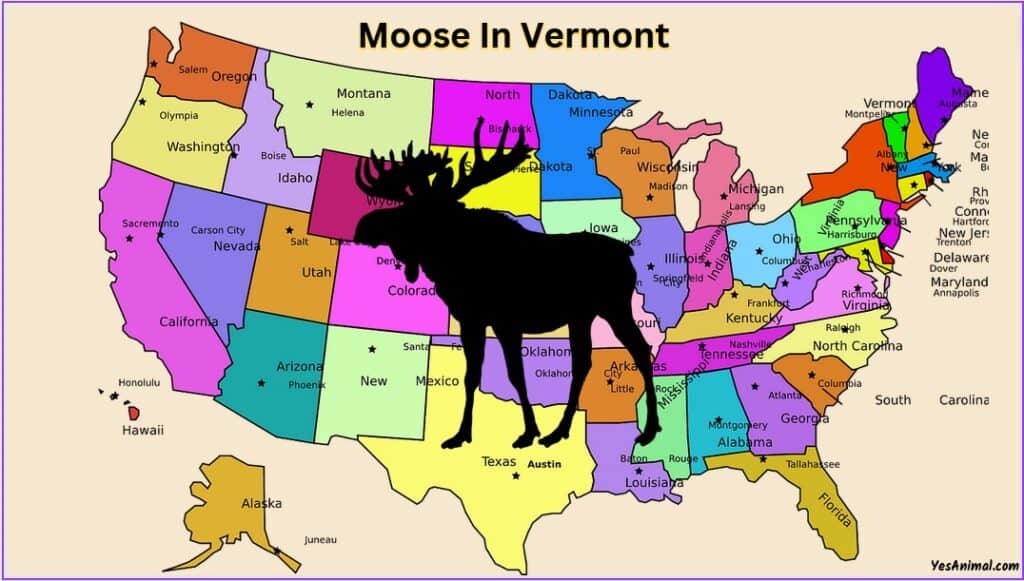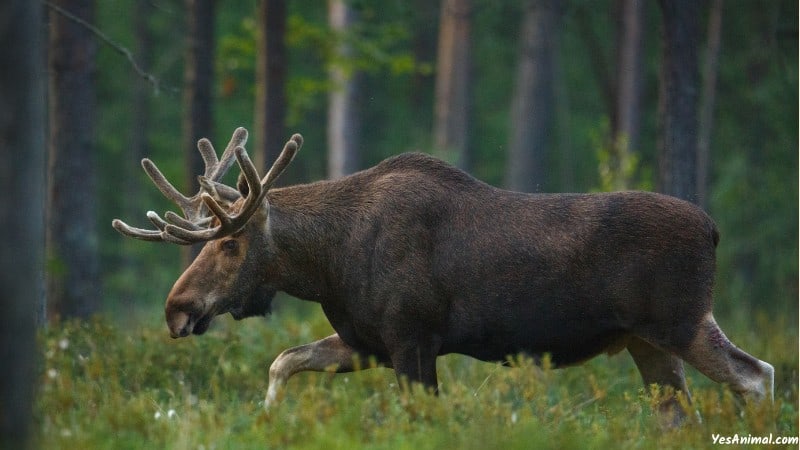Last Updated on September 14, 2023 by Amin Tawar

Vermont is well-known for its dairy farms, rolling hills, and stunning rural panorama. The state’s 75% of the land is forest areas and 15% is dairy farms. This accounts for the sparse population, beautiful scenery, and abundant wildlife including — the Moose.
Below In this article, I’ve explained everything you need to know about the Moose In Vermont, their population in the state, and which are the best spot to see them in the Vermont wild.
Are There Any Moose In Vermont?
Yes, there are moose in the state of Vermont. Before the European settlement in Vermont, that state was 95% forested. Therefore, it was excellent habitat for moose and other wildlife. As the state got densely settled, loss of habitat and overhunting, played a major role in the moose population being stumped out from Vermont.
During the mid-nineteenth century, just 35% of Vermont was forested. This was because the wooded hillside region was being transformed into farmland. The last moose was killed in 1899, in northeastern Vermont. In the 1900s, Vermont’s hillside farms were deserted and this led to forests reverting.
By the end of the 1960s, about 25 moose were living in Essex County, in the northeastern corner. With no natural predators moose population in Vermont grew rapidly. As the moose population in Vermont expanded, the state held the first moose hunting in the year 1993.
How Many Moose In Vermont? Vermont Moose Population?
The Vermont Fish and Wildlife Department voices the green mountain state houses about 2100 moose. The majority of the Vermont moose population resides around the Northeast Kingdom.
Approximately half of the moose population lives in Essex County and in the span of the Green Mountains, from the Massachusetts boundary in the southern region to the Quebec-Canada boundary in the northern region.
How Common Is It To See Moose In Vermont?
Though moose are high in number they are not very common to be seen in Vermont, this is because they are not a social species. Also, during summer moose do not like the heat and need access to cooling waters or dense shade.
This makes them more uncommon to be spotted in the state. You can however may see several together, particularly at favored feeding sites in winter.
These animals move to hardwoods found near softwood shelters in the fall, where there is more winter food, particularly in recently cut-over areas.
Also Check Our Guide On Moose In America
Where To See Moose In Vermont?

The Vermont Fish & Wildlife Department officials say the excellent time to see a moose, is right after the snow has melted down. In summer, they are found around wetlands, dining on vegetation.
Also, regardless of season, they can be seen in the early evening and morning, when they are out to eat. Here are a few best places to spot moose in Vermont.
- Wetlands of the Northeast Kingdom
These beautiful wetlands of the Northeast Kingdom have dense natural habitats, that make the perfect habitat for moose. You can take Route 114 between Caanan and East Burke or Route 105, between Bloomfield and Island Pond. Moose can be seen in the areas in late spring and summer. Moreover, if you want to get to watch moose in Vermont, you must consider checking the Victory Basin Wildlife Management and West Mountain Areas.
- Island Pond
Many people camping in this natural wonder have stated their exciting experiences of spotting moose in the area. You and a moose can be in the exact surroundings. Moose also like this area because of the lush nature and abundance of water and food that is effortlessly accessible. Also, this area is an excellent example of a location where moose truly feel safe.
- Branbury Pond
Moose are great at swimming, and they consider visiting the Branbury Pond occasionally. Also, the summer overheating makes this spot a great choice to get cool of the heat with the calm shade and water. Also, this palace has many recreational activities available as you stay for a moose to reveal itself.
- Ricker Pond
This Vermont State Park is a must-visit if you are eager to see a moose unlike another. Many people have stated that they have seen a moose near the dam. Do not be surprised if you catch them going swimming and coming up.
- Mount Worcester
When you go mount hiking you can experience the beauty of wildflowers along with moose. Though it isn’t a wetland, the trail is quite wet where you can see footprints of moose across the trail. It can be a difficult terrain, but the moose sighting will make it a quite thrilling experience.
- Kettle Pond
This Vermont State Park is a great place to see something exciting. Visitors usually visit to fish but end up seeing many wildlife including moose. Also, the place is known to have everything that a moose prefers.
Therefore, the area makes moose sighting an easy and amazing experience. The Kettle Pond is certainly worth your visit if other moose sightings have failed.
How Big Are Moose In Vermont?
Being the largest species of the deer clan, an adult male moose can stand up to 6 feet tall at shoulder levels and can weigh around 1,400 pounds. The female moose are quite smaller in size when compared to the male moose.
Heavy-bodied with a bump on their back, moose have large heads, with a flap of flesh hanging underneath their chin.
All moose have longer legs, allowing them to jump above fallen trees. Moose might vary in color from dusty black to light brown, with their face usually being black or dark brown on bulls, and soft brown on cows.
Can You Hunt Moose In Vermont?
The Vermont Fish & Wildlife Board handles the moose herds in the state through wildlife management divisions. This permits them to either decrease or add moose permits in a distinctive wildlife management division relying on moose population goals.
In current years, the majority of Vermont’s moose hunting has been closed. In 2022 and 2021, the whole state was closed with the exception of Division E to moose hunting, which is the northeastern region, bounding Canada on the north and New Hampshire on the east.
Moose permits are granted via a lottery system, by the management division. This enables the department to increase or limit the harvest numbers every year by region. Successful candidates are allowed to select a guide and a second shooter.
As stated, in the last 2 years, 100 permits were issued by the wildlife management in Division E, which was the only open area for moose hunting in Vermont. This policy can be modified by Vermont’s wildlife board if the needs force them to do so.
The objective of the Vermont Fish & Wildlife Commission is to keep the moose population density in the state within a few numbers. Thus only if the numbers increase then they will open the hunting in all divisions or they might be open only in a few divisions.
Also Check Our Guide On Moose In Utah
Conclusion
And that was everything you need to know about the moose Population in Vermont. I hope this article answered all your queries.
Thank You For Reading!
Our Source For This Guide